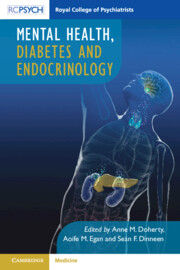Book contents
- Mental Health, Diabetes and Endocrinology
- Mental Health, Diabetes and Endocrinology
- Copyright page
- Contents
- Contributors
- Preface
- Chapter 1 An Introduction to Psychiatry in Endocrinology
- Chapter 2 Depression across Endocrine Disorders
- Chapter 3 Antipsychotic Medications and Metabolic Syndrome
- Chapter 4 ‘Diabulimia’, Diabetes and Eating Disorders
- Chapter 5 Disorders of the Hypothalamic–Pituitary–Adrenal Axis
- Chapter 6 Disorders of the Thyroid and Parathyroid
- Chapter 7 Psychological Factors Impacting on Endocrine Disorders and Self-Management and Medication-Taking Behaviour
- Chapter 8 Cognitive Impairment and Endocrine Conditions
- Chapter 9 Suicidal Ideation and Self-Harm
- Chapter 10 Obesity and Mental Health
- Chapter 11 Gender Incongruence
- Chapter 12 Anti-androgens in Forensic Psychiatric Settings
- Chapter 13 Service- and Setting-Related Challenges
- Index
- References
Chapter 11 - Gender Incongruence
Key Considerations in Transitioning
Published online by Cambridge University Press: 14 October 2021
- Mental Health, Diabetes and Endocrinology
- Mental Health, Diabetes and Endocrinology
- Copyright page
- Contents
- Contributors
- Preface
- Chapter 1 An Introduction to Psychiatry in Endocrinology
- Chapter 2 Depression across Endocrine Disorders
- Chapter 3 Antipsychotic Medications and Metabolic Syndrome
- Chapter 4 ‘Diabulimia’, Diabetes and Eating Disorders
- Chapter 5 Disorders of the Hypothalamic–Pituitary–Adrenal Axis
- Chapter 6 Disorders of the Thyroid and Parathyroid
- Chapter 7 Psychological Factors Impacting on Endocrine Disorders and Self-Management and Medication-Taking Behaviour
- Chapter 8 Cognitive Impairment and Endocrine Conditions
- Chapter 9 Suicidal Ideation and Self-Harm
- Chapter 10 Obesity and Mental Health
- Chapter 11 Gender Incongruence
- Chapter 12 Anti-androgens in Forensic Psychiatric Settings
- Chapter 13 Service- and Setting-Related Challenges
- Index
- References
Summary
People who are transgender and gender non-conforming (TGNC) include people whose experienced gender is different from their assigned sex at birth, and they have specific healthcare needs. As the number of people identifying as TGNC is increasing internationally, it is important that endocrinologists, psychiatrists and indeed all health professionals have a good understanding of the issues related to the physical and mental healthcare of transgender people. People who identify as TGNC experience a disproportionate amount of violence, discrimination and stigma, and these factors contribute to poorer outcomes. There is also a high rate of comorbidity in young people who are TGNC, including mood disorders, eating disorders, suicidal ideation and self-harm. Compounding these mental health problems are the effects of social exclusion (including educational and employment), which often places TGNC people at risk, especially during transitioning. Transgender people should have access to expert guideline-based care that allows them to transition safely and to optimise their health and well-being.
- Type
- Chapter
- Information
- Mental Health, Diabetes and Endocrinology , pp. 116 - 126Publisher: Cambridge University PressPrint publication year: 2021



